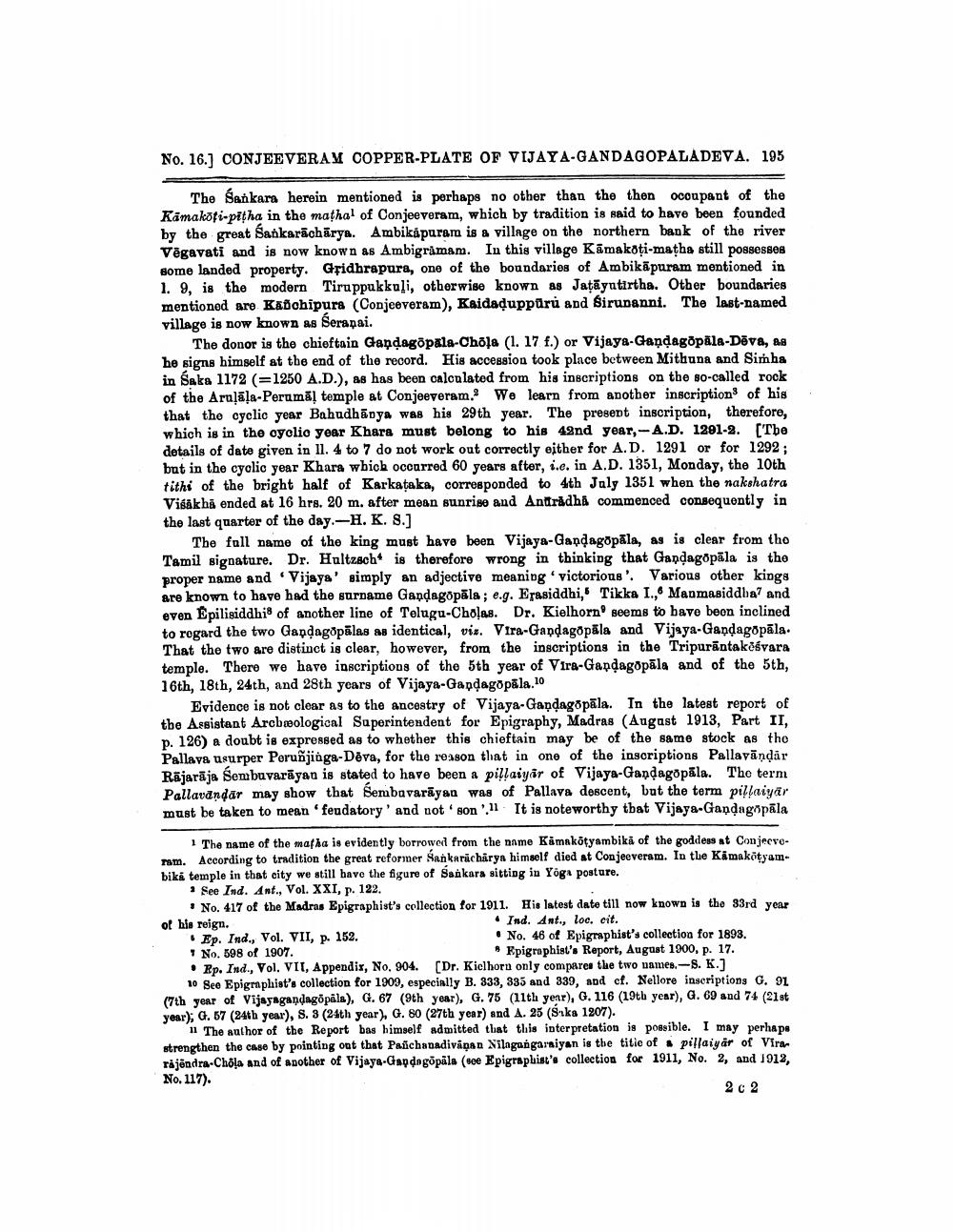________________
No. 16.] CONJEEVERAM COPPER-PLATE OF VIJAYA-GANDAGOPALADEVA. 195
The Sankara herein mentioned is perhaps no other than the thon ocoupant of the Kamakoti-pitha in the mathal of Conjeeveram, which by tradition is said to have been founded by the great Sankarāchārya. Ambikapuram is a village on the northern bank of the river Vēgavati and is now known as Ambigramam. In this village Kāmakoti-matha still possesses some landed property. Gridhrapura, one of the boundaries of Ambikāpuram mentioned in 1. 9, is the modern Tiruppukkoli, otherwise known as Jatāyatirtha. Other boundaries mentioned are Kanchipura (Conjeeveram), Kaidaduppuru and Sirunanni. The last-named village is now known as Serapai.
The donor is the chieftain Gandagopala-Chola (1. 17 f.) or Vijaya-Gandagopala-Dēva, as he signs himself at the end of the record. His accession took place between Mithuna and Simba in Saka 1172 (=1250 A.D.), as has been calculated from his inscriptions on the so-called rock of the Aruļāļa-Perumal temple at Conjoeveram. We learn from another inscription of his that the cyclic year Bahudhāpya was his 29th year. The present inscription, therefore, which is in the cyclio year Khara must belong to his 42nd year, -A.D. 1291-2. [Tbe details of date given in 11. 4 to 7 do not work out correctly either for A.D. 1291 or for 1292; but in the cyclic year Khara wbich occurred 60 years after, i.e. in A.D. 1351, Monday, the 10th tithi of the bright half of Karkataka, corresponded to 4th Jaly 1351 when the nakshatra Visakhi ended at 16 hrs. 20 m. after mean sunrise and Antradha commenced consequently in the last quarter of the day.-H. K. 8.]
The full name of the king must have been Vijaya-Gandagopāla, as is clear from the Tamil signature. Dr. Hultzsch is therefore wrong in thinking that Gandagopāla is the proper name and Vijaya' simply an adjective meaning 'victorious'. Various other kinga are known to have had the surname Gandagopāla; e.g. Erasiddhi, Tikka I., 9 Maomasiddha and even EpilisiddhiR of another line of Telugu-Cholas. Dr. Kielhorn seems to have been inclined to rogard the two Gapdagopālas as identical, vix. Vira-Gandagopala and Vijaya-Gandagopāla. That the two are distinct is clear, however, from the inscriptions in the Tripurāntakośvara temple. There we have inscriptions of the 5th year of Vira-Gandagopāla and of the 5th, 16th, 18th, 24th, and 28th years of Vijaya-Gandagopāla.10
Evidence is not clear as to the ancestry of Vijaya-Gandagopala. In the latest report of the Assistant Archeological Superintendent for Epigraphy, Madras (August 1913, Part II, p. 126) a doubt is expressed as to whether this chieftain may be of the same stock as the Pallava usurper Poruñjinga-Dēva, for the reason that in one of the inscriptions Pallavändar Rājarāja Sembuvarāyan is stated to have been a pillaiyar of Vijaya-Gandagopāla. The term Pallavandar may show that Sembavarāyan was of Pallava descent, but the term pillaiyar must be taken to mean feudatory' and not son '.11 It is noteworthy that Vijaya-Gandagopala
1 The name of the mafha is evidently borrowed from the name Kimakotyambikå of the goddess at Conjecromm. According to tradition the great reformer Sankaracharya himself died at Conjeeveram. In the Kimakotyam. biki temple in that city we still have the figure of Sankara sitting in Yög posture.
· See Ind. Ant., Vol. XXI, p. 122.
No. 417 of the Madras Epigraphist's collection for 1911. His latest date till now known is the 33rd year of his reign.
• Ind. Ant., loc. cit. Ep. Ind., Vol. VII, p. 152.
• No. 46 of Epigraphist's collection for 1893. No. 598 of 1907.
Epigrophist's Report, August 1900, p. 17. • Rp. Ind., Vol. VIT, Appendix, No. 904. [Dr. Kielhorn only compares the two names.-S. K.]
10 See Epigraphist's collection for 1909, especially B. 333, 335 and 339, and cf. Nellore inscriptions G. 91 (7th year of Vijagagandagöpäls), G. 67 (9th year), G. 75 (11th year), G. 116 (19th year), G. 69 and 74 (21st year); G. 57 (24th year), S. 3 (24th year), G. 80 (27th year) and A. 25 (suka 1207).
11 The author of the Report bas himself admitted that this interpretation is possible. I may perhape strengthen the case by pointing out that Patchanadiváñan Nilagangariyan is the title of pillaiyar of Virarájöndra-Chöļa and of another of Vijaya-Gapdogõpāla (80e Epigraphist's collection for 1911, No. 2, and 1912, No. 117).
2 c 2




